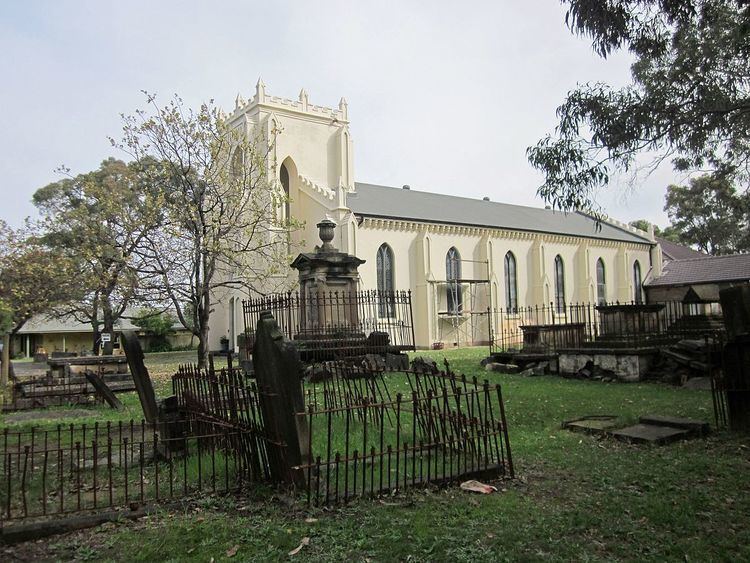Phone +61 2 9557 2332 | ||
 | ||
Address 187 Princes Hwy, St Peters NSW 2044, Australia | ||
St Peters Anglican Church, St Peters, 187-209 Princes Highway, St Peters, New South Wales, is one of the oldest churches in the suburbs of Sydney. It was designed by Thomas Bird.The church is sometimes referred to as "St Peters, Cooks River," as it is located in the Anglican Parish of Cooks River, New South Wales. Cooks River itself, named by James Cook in 1770 when he sailed into Botany Bay, is crossed by the Princes Highway, about 3 kilometers to the south of the church. The suburb of St Peters, New South Wales, in which the church is located, was named as a result of the area's proximity to the church.
Contents
The site contains three main buildings (St Peters Church and hall; a former rectory, built in 1906; and the present rectory, built in 1996) and a remnant graveyard.
The church building is unique in that it is built of sun-dried bricks with stuccoed finish forming the walls. The surface of the walls are expressed to simulate stonework and have attached buttresses supported on sandstone footings integrated into the sandstone footings of the walls.
The church is listed on the New South Wales State Heritage Register and the Register of the National Estate.
History
The area on which the church stands forms part of the territory of the Darug people.
Land which now contains the church site was granted to Thomas Smyth in 1799. Some of Smyth's grant, including the church site, was acquired by Robert Campbell. The church site comprising 6 acres 14 perches was transferred by Campbell, in 1837, to the "Bishop of Australia" for the erection of the church.
Campbell's land was subdivided into forty-two allotments, thirteen of which were purchased by Alexander Brodie Spark, an established Sydney merchant, who had built and resided at "Tempe House". Spark, as the largest landowner in Campbell's subdivision, was highly active in the local community.
Tenders were called for the erection of the church, to the designs of the architect Thomas Bird. Spark may have been influential in the selection of the architect who was engaged by Spark to design improvements to "Tempe House." On 16 April 1838 Spark was elected as one of the five trustees of the church, together with The Lord Bishop of Australia, Robert Campbell, John Lord and David Chambers.
On 13 May 1838 the first service was conducted in a temporary church. The foundation stone of the present church was laid on 7 July 1838, and the building was completed in November 1839.
In 1880 a pipe organ made by Brindley & Foster of Sheffield, England, was installed in the gallery of the church.
The spire of the church and the bell chamber were removed in 1963 because they had become structurally unsound.
Cemetery
The first burial in the graveyard, that of John Benfield, a soldier, took place on 4 March 1839, although the graveyard was not consecrated until 26 December 1840. The final burial, that of Sarah Ann Sargent, a widow, took place on 10 April 1896.
In February 1948 an Act of the New South Wales Parliament (Act No. 48 of 1968) was passed authorising the use of the cemetery land for purposes other than a cemetery, including use as a rest park, a garden area and a recreation area. However no action was taken at the time and, in 1979, a permanent conservation order was placed on all of the church property by the Heritage Council of New South Wales.
Since that time the congregation have undertaken voluntary maintenance of the cemetery grounds. A listing of all of the headstones was made in 1985 and photographs have been taken of many of the headstones.
